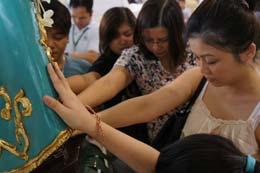Catholic leaders reach out to Filipinos

The seven-story Robinsons Place in Manila is a temple of consumerism.
It houses about 350 stores, including gun shops, dental offices, massage parlors, and a Kenny Rogers Roaster.
The music and the crowds can be a little overwhelming after a while. But up on the fourth floor, next to the Cineplex and a barber shop, the atmosphere is more soothing.
A Catholic Mass is being offered for hundreds of Filipino mall-goers who are seated in plastic chairs around a makeshift altar. To reach his congregants, the priest switches between English and the local language, Tagalog.
The Catholic Church in the Philippines is doing all it can to reach out, reports world.org
Even though the Philippines is the third largest Catholic country in the world, the Church has been losing followers. In this hot, humid country, many families prefer to spend Sundays in climate-controlled malls than in church. So the priests have followed them.
Recently, upset over a new law that provides poor Filipinos with easier access to birth control methods, Catholic Church leaders threw their weight ahead of the May 13 midterm elections — but they miscalculated their heft.
In cathedrals around the country, clergymen hung red-and-black banners asking the faithful to vote for legislative candidates who oppose the Reproductive Health Law, which they view as a first step towards legalizing abortion. These candidates comprised what some bishops and priests dubbed “Team Life” while those who favored the law were branded by conservative Catholics as “Team Death.”
But many “Team Death” candidates triumphed and in the aftermath of the voting, Ramon Arguelles, the archbishop of the city of Lipa, told reporters: “I am not happy.”
A growing number of Filipino Catholics apparently feel the same way about their church. Although the Philippines remains the third-largest Roman Catholic country in the world after Brazil and Mexico, experts say that the influence of church leaders has been steadily declining as Filipinos disregard Catholic doctrine or, in some cases, find other faiths.
Many people disagree with the church’s conservative stance on social issues and some have become disillusioned by the Vatican’s slow response to the church sexual abuse scandals. Mirroring so-called “de-churchification” in other predominantly Catholic countries, a recent survey showed that only 37 percent of Filipino Catholics go to Mass compared to 66 percent in 1991.
Even so, the church remains one of the country’s most powerful institutions. About 80 percent of the 100 million people in the Philippines consider themselves Catholics, a legacy of 350 years of Spanish colonial rule. Politicians often refrain from crossing the church which is why both abortion and divorce remain illegal. Newspapers carry religious columns with names like “Our Daily Bread.” Besides churches, Mass is sometimes held in shopping malls, banks and other nontraditional venues.
But more recently, the institution has seemed badly out of step with average Filipinos.
For example, the Reproductive Health Law mandates that the government provide free condoms, birth control pills and other contraceptive methods to people who can’t afford them and provide sex education in public schools. Public health officials say the law is extremely important in a country where more than a quarter of the population is poor and where teen pregnancies are common.
The church hierarchy firmly opposed the law which was approved in December after similar proposals over the past two decades had gone down to defeat. Even so, the Supreme Court in March suspended its implementation until judges hear arguments from Catholic groups that have filed petitions arguing the legislation is unconstitutional.
Leave a comment






